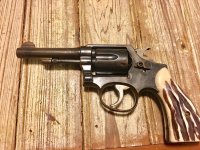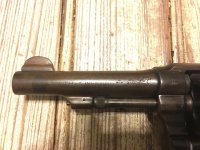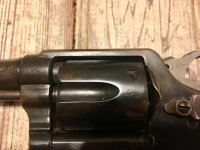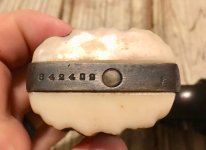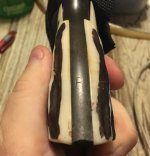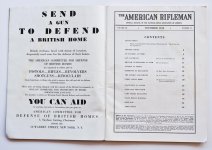lageologist
Member
- Joined
- Dec 10, 2018
- Messages
- 5
- Reaction score
- 6
I inherited this gun when my grandfather passed about 15 years ago. I've read many posts about victory models, and my gun doesn't seem to fit with the normal victory models.
Some specs:
Serial number is 842XXX with no V or SV in front of it. It looks like there used to be a lanyard attachment that is now plugged. The SN is also stamped forward of the lanyard attachment. The victory model pictures I've seen have it stamped behind it. There is a partial stamped letter on the butt too. It might be a P or B or maybe an H (see pics). The SNs match on all 3 places.
4" barrel that seems to have been shortened after-market. I think this because the front sight cuts off the words "Smith and Wesson" on the top of the barrel. The front sight was also shortened.
It was reamed for 38 special and has BNP stamps all over it.
It says made in USA and has caliber stamps for the UK.
The back of the frame in the handle has a P stamped on it.
The shortened barrel, lanyard loop hole, and original caliber suggests it was built to British specifications (5" barrel and 38-200 cartridge) and sent over during lend-lease.
Some questions:
Were the guns tested and stamped BNP only if they were reamed for 38 spl or did they test and proof all calibers that left military service? This could help me determine when the modifications took place.
What's up with the serial number? Is it a very late victory model or post war and they just didn't put the V there for some reason? Does it pre-date the practice of putting the V?
I've included some pictures. Please excuse the bad condition of the finish and the very ugly plastic grips. I plan on having it reblued at some point. My grandfather seems to have been the only person of that generation that didn't care about maintaining his stuff. Thank you all for any info on this gun.
Some specs:
Serial number is 842XXX with no V or SV in front of it. It looks like there used to be a lanyard attachment that is now plugged. The SN is also stamped forward of the lanyard attachment. The victory model pictures I've seen have it stamped behind it. There is a partial stamped letter on the butt too. It might be a P or B or maybe an H (see pics). The SNs match on all 3 places.
4" barrel that seems to have been shortened after-market. I think this because the front sight cuts off the words "Smith and Wesson" on the top of the barrel. The front sight was also shortened.
It was reamed for 38 special and has BNP stamps all over it.
It says made in USA and has caliber stamps for the UK.
The back of the frame in the handle has a P stamped on it.
The shortened barrel, lanyard loop hole, and original caliber suggests it was built to British specifications (5" barrel and 38-200 cartridge) and sent over during lend-lease.
Some questions:
Were the guns tested and stamped BNP only if they were reamed for 38 spl or did they test and proof all calibers that left military service? This could help me determine when the modifications took place.
What's up with the serial number? Is it a very late victory model or post war and they just didn't put the V there for some reason? Does it pre-date the practice of putting the V?
I've included some pictures. Please excuse the bad condition of the finish and the very ugly plastic grips. I plan on having it reblued at some point. My grandfather seems to have been the only person of that generation that didn't care about maintaining his stuff. Thank you all for any info on this gun.

